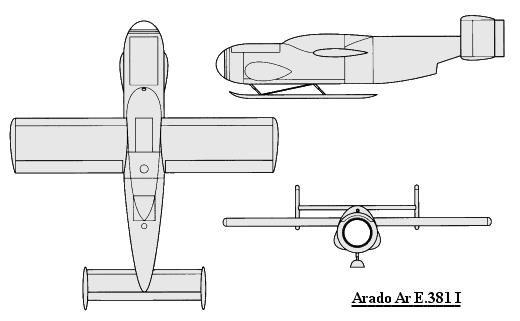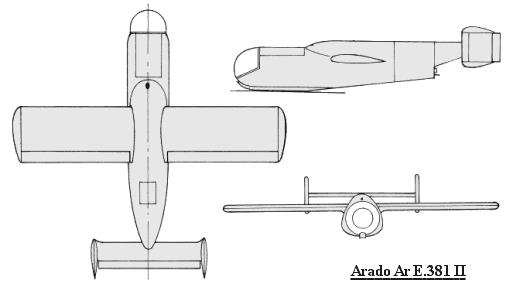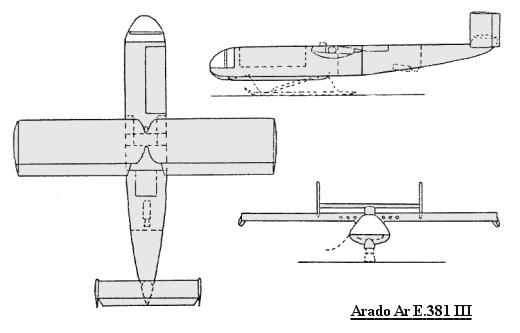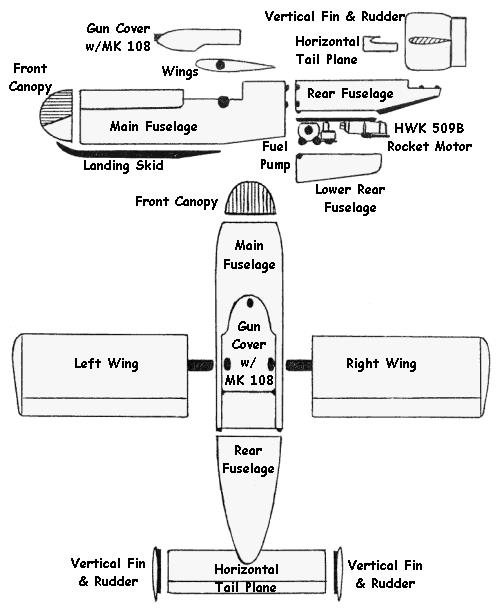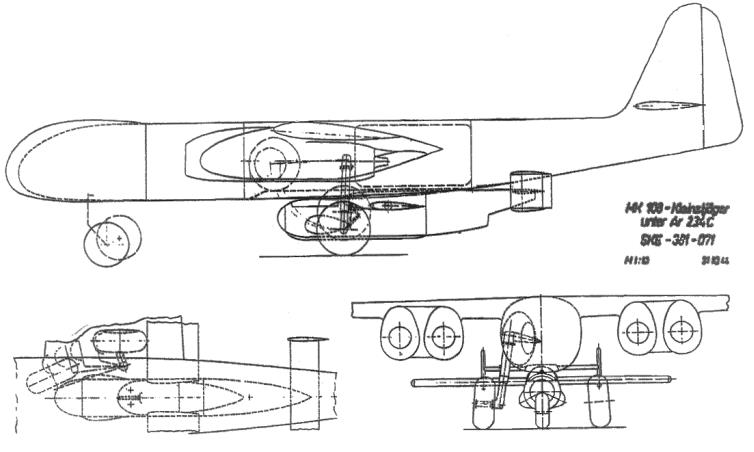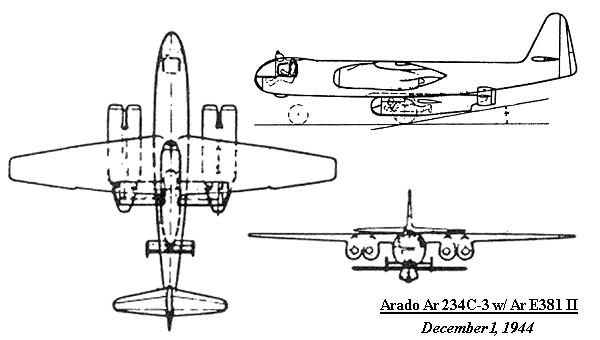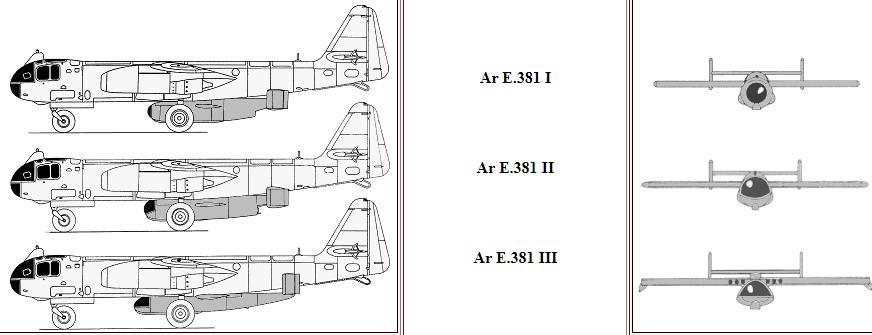| Type | E.381 I Single seat parasite fighter | E.381 II Single seat parasite fighter | E.381 III Single seat parasite fighter |
| Engine | 1 Walter 509B | ||
| Dimensions | Length 4,69 m , height 1,29 m , span 4,43 m, wing area 5,0 m2 , | Length 4,95 m, height 1,15 m , span 5,0 m, wing area 5,0 m2 | Length 5,70 m , height 1,51 m , span 5,05 m , wing area 5,5 m2 |
| Weights | Empty , loaded 1200 kg , max. take off weight | Empty , loaded 1265 kg, max. take off weight | Empty , loaded 1500 kg, max. take off weight |
| Performance | Max.. speed 900 km/h | Max.. speed 885 km/h | Max.. speed 895 km/h, |
| Armament | |||
In late 1944, Arado submitted their E.381 parasite miniature fighter to the RLM (German Air Ministry). some of the other parasite fighters included the Messerschmitt Me P.1103/I , P.1103/II , P.1104/I , P.1104/II , Sombold So 344 and the Zeppelin "Rammer" . The Ar E.381 went through several different designs, each improving on the last. All versions were basically an armored tube with a small Walter 509B rocket engine providing limited power, and all versions were to glide to the ground and land on a landing skid and slowed by a deployed drag parachute. Also, all versions of the Arado Ar E.381 were to be carried beneath an Arado Ar 234C-3 4-jet bomber.
The first version had a circular cross-section fuselage, with a small round window in the nose for the pilot's vision. Overall, the entire fuselage was protected by a 5mm armored shell. The pilot lay in a prone position, and the cockpit was very cramped. A removable 140mm (5.5 inch) armored glass screen was mounted in front of the pilot. Two small bulges were located on the fuselage sides for the pilot's elbows. Alongside the pilot's legs were two C-Stoff (one component of the rocket fuel) fuel tanks and by his feet a single T-Stoff fuel tank. The wings were straight and mounted midfuselage, with a stepped bulge above the wings which held the single MK 108 30mm cannon with 60 rounds. The rocket engine exhausted beneath the tail unit which featured a twin fin and rudder setup. A retractable skid could be lowered for landing and a drag parachute (ejected from a hatch on the top rear fuselage) was also to be used upon landing. The aircraft could only be entered from a hatch above the cockpit, so the pilot had to enter the E.381 before the aircraft could be attached to the carrier Ar 234C-2 and had no way to escape in case of emergency.
The second version was very similar to the first version of the Ar E.381. The overall dimensions were enlarged slightly, but the basic layout remained the same. The front canopy was enlarged, giving the prone lying pilot better vision out of the still cramped cockpit. A slight step still remained aft of the entry hatch atop of the forward fuselage, and a single MK 108 30mm cannon (45 rounds) was still mounted here, firing over the cockpit. The tail unit was similar, with the fins being slightly smaller and rounder. Landing was accomplished by means of a built-in landing skid and the same drag parachute, and the same means of entering and exiting the second version of the E.381 (via a hatch on top of the fuselage) remained from the first version.
With the third E.381 design, the overall dimensions were again enlarged slightly. The fuselage shape was designed as a triangular cross-section now, which presented an even smaller front cross-section. The step above the fuselage was eliminated, and the wing was now a shoulder mount design. Also, the wing tips were turned downwards, to act as skids once the plane landed and tipped from side to side. Instead of a single MK 108 30mm cannon, the third version was armed with six RZ65 or 73 spin-stabilized rockets fired from the wing leading edges. The tail unit was redesigned to sit slightly higher than the fuselage and the fin and rudders changed to a simpler rectangular shape. Landing was the same as the first two versions, via a retractable landing skid and drag parachute. The problem of entering or exiting the E.381 was solved by adding a side-opening hatch on the starboard side of the forward fuselage.
The E.381 was to be attached to the underside of the Arado Ar 234C-3 and to clear the Ar 234's undercarriage upon retraction, the E.381 had to be mounted aft of the carrier aircraft's center of aircraft. This meant that the E.381's wings had to give lift from the start of the flight. Because the E.381 was so small and simple, the carrier aircraft provided heating, electrical and telephone links to the E,381. The telephone link was used to tell the pilot of the E.381 to help make necessary trim changes. Once the coupled aircraft was carried aloft, it was released at a height of 1000 meters (3281 feet) above the enemy bomber formations. It would then make its approach in a shallow, high-speed dive, reaching a speed of 820 km/h (510 mph) where an initial attack would take place. The small Walter 509B rocket motor would be ignited for a second attack pass, and then the E.381 would begin a long diving glide back to the ground. Upon landing using its built-in landing skid and braking parachute, the E.381 could be easily dismantled (into wing, fuselage and tail unit) into pieces light enough to be handled manually and then loaded into a truck.
It was estimated that it would take 600 man-hours of work to produce the E.381. The materials used were to be 350 kg of steel, 320 kg of sheet steel, 120 kg of wood and 40 kg of light metal for a total of 830 kg . A mock-up was built and several unpowered wooden airframes were also said to be constructed, and it is even rumored that a single unmanned prototype was tested by being towed aloft. No powered examples were ever built or flown, and the RLM decided against pursuing production of the Arado Ar E.381 or any of the other parasite aircraft that had been submitted.
The first version had a circular cross-section fuselage, with a small round window in the nose for the pilot's vision. Overall, the entire fuselage was protected by a 5mm armored shell. The pilot lay in a prone position, and the cockpit was very cramped. A removable 140mm (5.5 inch) armored glass screen was mounted in front of the pilot. Two small bulges were located on the fuselage sides for the pilot's elbows. Alongside the pilot's legs were two C-Stoff (one component of the rocket fuel) fuel tanks and by his feet a single T-Stoff fuel tank. The wings were straight and mounted midfuselage, with a stepped bulge above the wings which held the single MK 108 30mm cannon with 60 rounds. The rocket engine exhausted beneath the tail unit which featured a twin fin and rudder setup. A retractable skid could be lowered for landing and a drag parachute (ejected from a hatch on the top rear fuselage) was also to be used upon landing. The aircraft could only be entered from a hatch above the cockpit, so the pilot had to enter the E.381 before the aircraft could be attached to the carrier Ar 234C-2 and had no way to escape in case of emergency.
The second version was very similar to the first version of the Ar E.381. The overall dimensions were enlarged slightly, but the basic layout remained the same. The front canopy was enlarged, giving the prone lying pilot better vision out of the still cramped cockpit. A slight step still remained aft of the entry hatch atop of the forward fuselage, and a single MK 108 30mm cannon (45 rounds) was still mounted here, firing over the cockpit. The tail unit was similar, with the fins being slightly smaller and rounder. Landing was accomplished by means of a built-in landing skid and the same drag parachute, and the same means of entering and exiting the second version of the E.381 (via a hatch on top of the fuselage) remained from the first version.
With the third E.381 design, the overall dimensions were again enlarged slightly. The fuselage shape was designed as a triangular cross-section now, which presented an even smaller front cross-section. The step above the fuselage was eliminated, and the wing was now a shoulder mount design. Also, the wing tips were turned downwards, to act as skids once the plane landed and tipped from side to side. Instead of a single MK 108 30mm cannon, the third version was armed with six RZ65 or 73 spin-stabilized rockets fired from the wing leading edges. The tail unit was redesigned to sit slightly higher than the fuselage and the fin and rudders changed to a simpler rectangular shape. Landing was the same as the first two versions, via a retractable landing skid and drag parachute. The problem of entering or exiting the E.381 was solved by adding a side-opening hatch on the starboard side of the forward fuselage.
The E.381 was to be attached to the underside of the Arado Ar 234C-3 and to clear the Ar 234's undercarriage upon retraction, the E.381 had to be mounted aft of the carrier aircraft's center of aircraft. This meant that the E.381's wings had to give lift from the start of the flight. Because the E.381 was so small and simple, the carrier aircraft provided heating, electrical and telephone links to the E,381. The telephone link was used to tell the pilot of the E.381 to help make necessary trim changes. Once the coupled aircraft was carried aloft, it was released at a height of 1000 meters (3281 feet) above the enemy bomber formations. It would then make its approach in a shallow, high-speed dive, reaching a speed of 820 km/h (510 mph) where an initial attack would take place. The small Walter 509B rocket motor would be ignited for a second attack pass, and then the E.381 would begin a long diving glide back to the ground. Upon landing using its built-in landing skid and braking parachute, the E.381 could be easily dismantled (into wing, fuselage and tail unit) into pieces light enough to be handled manually and then loaded into a truck.
It was estimated that it would take 600 man-hours of work to produce the E.381. The materials used were to be 350 kg of steel, 320 kg of sheet steel, 120 kg of wood and 40 kg of light metal for a total of 830 kg . A mock-up was built and several unpowered wooden airframes were also said to be constructed, and it is even rumored that a single unmanned prototype was tested by being towed aloft. No powered examples were ever built or flown, and the RLM decided against pursuing production of the Arado Ar E.381 or any of the other parasite aircraft that had been submitted.
